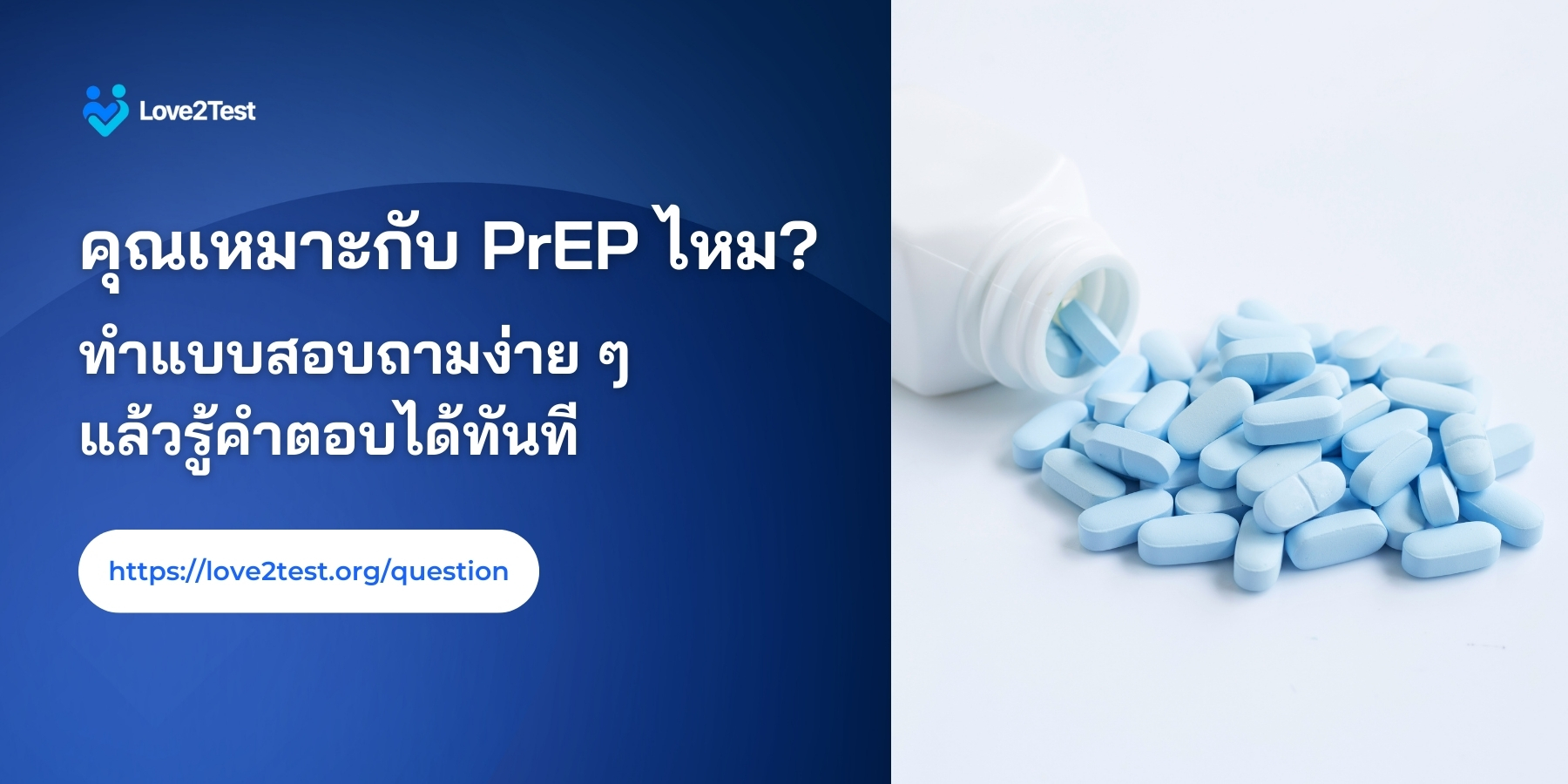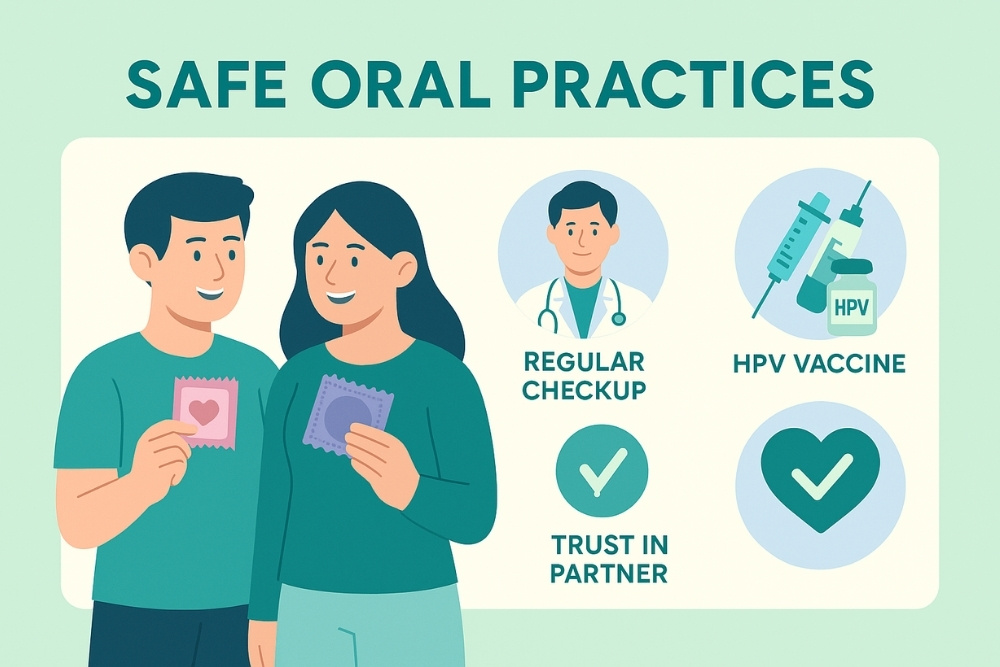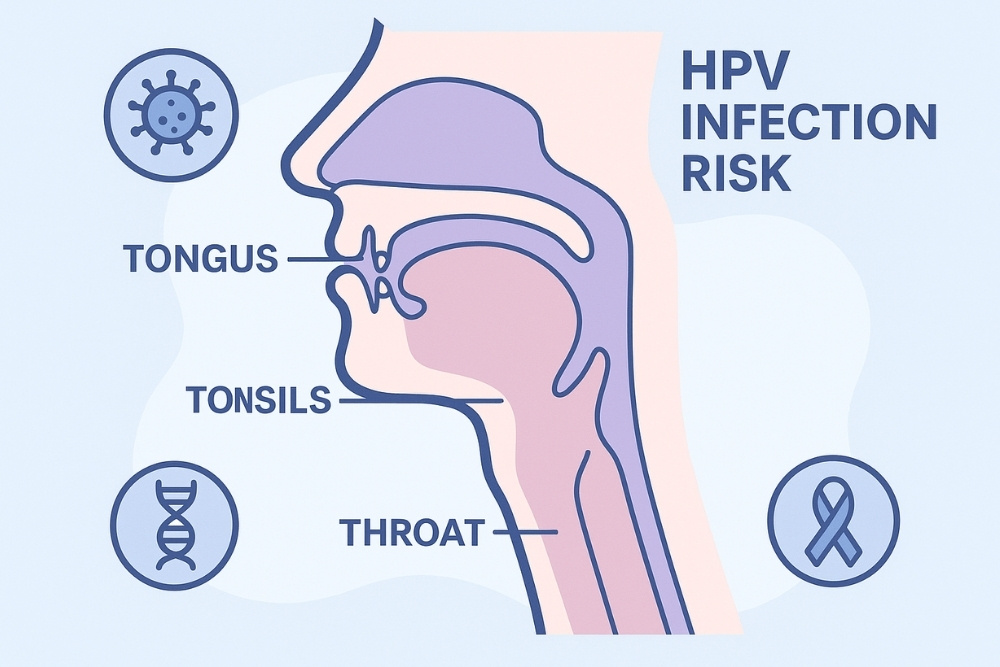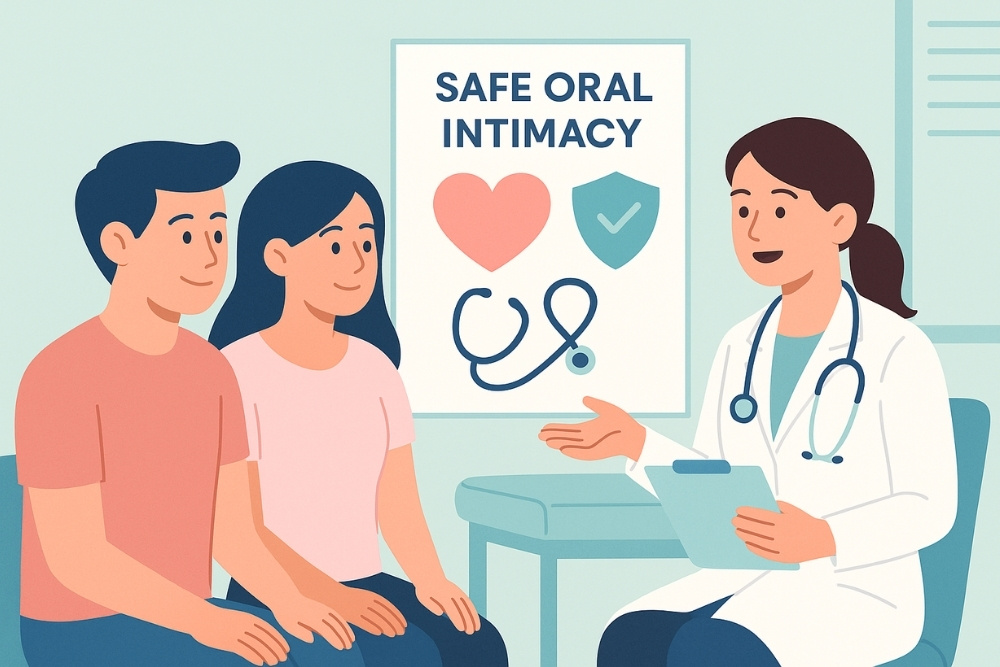Research from the United Kingdom has found that about 1.9% of sex workers were diagnosed with throat gonorrhea, a sexually transmitted infection that can occur through oral sex. Meanwhile, a study published in the New England Journal of Medicine reported that around 50% of oral cancer cases are linked to HPV (Human Papillomavirus), often transmitted through oral sexual contact. The same research also noted that individuals who have performed oral sex on five or more partners without protection are nine times more likely to develop tonsil or tongue cancer compared to the general population.
Oral sex is one of the most common forms of sexual activity among couples — regardless of gender or sexual orientation. It’s a natural and consensual act that many people consider an expression of intimacy and pleasure. Engaging in oral sex does not indicate any psychological abnormality; rather, it’s a personal and mutual choice between partners. However, while oral sex can enhance pleasure and emotional connection, it’s important to remember that it also carries potential health risks. The mouth and throat can serve as entry points for sexually transmitted infections such as gonorrhea, syphilis, chlamydia, herpes, HPV, and even hepatitis A.
Without proper protection, what begins as a moment of pleasure could lead to long-term health consequences.
The Benefits of Oral Sex
Oral sex is one of the most common forms of sexual activity that many couples engage in to increase intimacy and satisfaction in their relationships. It offers variety in sexual expression without necessarily involving penetration. One of the most obvious advantages is that oral sex does not cause pregnancy. Since there is no contact between sperm and egg, many people consider it a “safer” option compared to penetrative sex. However, it’s still important to be aware that sexually transmitted infections (STIs) can be transmitted through oral fluids or mucous membranes in the mouth.

Beyond the issue of pregnancy prevention, oral sex has several other benefits:
- Enhances sexual pleasure for both partners The use of the mouth, tongue, and lips creates sensations different from other forms of touch, helping couples learn more about each other’s erogenous zones and sexual preferences.
- Promotes emotional intimacy Oral sex often requires trust and mutual consent. Exploring your partner’s body in such an intimate way can strengthen emotional connection, deepen affection, and build a stronger sense of closeness between partners.
-
A suitable option for those not ready for penetrative sex
For some couples—especially teenagers or those not yet ready physically or emotionally—oral sex can be a way to experience sexual pleasure without the risk of pregnancy.
- Adds excitement to a relationship Many couples use oral sex as part of foreplay to enhance arousal before intercourse, while others view it as a primary sexual activity that fulfills mutual satisfaction and intimacy.
According to international surveys, more than 70% of adults have experienced oral sex, and over 50% reported increased sexual satisfaction after engaging in it. This shows that oral sex is not merely a physical act but also an expression of emotional connection and communication between partners. Still, it’s essential to remember that while oral sex can be pleasurable and intimate, protection remains important. Using flavored condoms or dental dams can significantly reduce the risk of sexually transmitted infections and ensure the health and safety of both partners.
The Risks of Oral Sex
While oral sex is often seen as a safer alternative to penetrative sex, it is not risk-free. Without protection, you can still contract a variety of sexually transmitted infections (STIs) because the mouth, throat, and genital areas all contain mucous membranes that can absorb viruses and bacteria. Contact with vaginal fluids, semen, or infected skin can lead to infection.
Diseases and infections that can be transmitted through oral sex include:
- HIV (Human Immunodeficiency Virus)
- Although the risk of contracting HIV through oral sex is lower than through anal or vaginal intercourse, it is not zero. The risk increases when there are open cuts, sores, or bleeding gums in the mouth, or if the genitals of the receiving partner have fresh wounds. A sufficient viral load can still lead to transmission.
- Gonorrhea
- Gonorrhea can be transmitted to the throat (known as pharyngeal gonorrhea) or the genitals of both giving and receiving partners. Studies have found throat gonorrhea among sex workers and individuals who frequently engage in unprotected oral sex.
- Chlamydia
- Research shows that up to 10% of sexually active adolescents have genital chlamydia infections, while about 1% of LGBTQ individuals who engage in regular oral sex have throat chlamydia. Although throat infections often show no symptoms, they can still spread the bacteria to others.
- Syphilis
- Syphilis can be transmitted when the mouth or lips come into contact with syphilitic sores (chancres) on the genitals, anus, or nipples. Even small, painless sores can carry a high bacterial load, allowing infection to occur through oral contact.
-
Herpes (HSV-1 and HSV-2)
- Herpes is transmitted through direct skin-to-skin contact with infected sores or blisters. This means it can spread from the mouth to the genitals or vice versa during oral sex, even when sores are not clearly visible.
- Parasitic infections
- Certain parasites, such as pinworms, can be transmitted when their eggs near the anus are transferred to the mouth during oral–anal contact. These eggs can later hatch and grow in the large intestine, leading to reinfection and discomfort.
- Hepatitis A
- The hepatitis A virus is excreted in feces and can be transmitted through oral–anal contact (rimming) if proper hygiene is not maintained. Infection can cause liver inflammation, fever, and jaundice.
- Human Papillomavirus (HPV)
- HPV can infect the mouth, throat, and respiratory tract. It may cause genital warts and, in high-risk strains such as HPV-16 and HPV-18, can lead to oral cancers, including cancer of the tonsils, tongue, and throat.
While oral sex may seem like a safer or more intimate way to enjoy sexual activity, unprotected oral sex can still expose you to multiple STIs and viral infections. Using protection such as condoms or dental dams, maintaining good oral hygiene, and getting regular STI screenings are essential for keeping both you and your partner safe.


How to Practice Oral Sex Safely
Oral sex can be an enjoyable and intimate part of a relationship — but safety should always come first. Although the risk of sexually transmitted infections (STIs) is lower than with penetrative sex, infections can still be transmitted through oral contact. Here are some practical ways to make oral sex safer for you and your partner:
- Make sure your partner is free from HIV and other STIs. Open and honest communication is the first step to safer sex. If you or your partner haven’t been tested recently, consider getting screened before engaging in oral sex.
- Avoid brushing your teeth right before oral sex. Brushing or flossing can cause small cuts or irritation in the gums, creating tiny entry points for viruses or bacteria. Rinse your mouth instead if you want to freshen up beforehand.
-
Use flavored condoms or dental dams.
Flavored condoms can make oral sex more enjoyable while reducing the risk of infection. Dental dams — thin latex sheets — can also be used during oral–vaginal or oral–anal contact for additional protection.
- Be cautious if you have braces, tongue piercings, or oral jewelry. Metal wires or studs can accidentally tear condoms or cause small injuries to sensitive areas. Move gently and communicate with your partner.
- Avoid using lip balm or oil-based products before oral sex. Oils and certain balms can weaken latex, increasing the chance of condom breakage. Stick to water-based lubricants that are condom-safe if needed.
- Do not perform oral sex on someone with visible sores, warts, or cuts around the genitals. These could be signs of an active STI such as herpes, syphilis, or HPV. Even with a condom, the risk of infection may still be present if the affected area is not fully covered.
By following these precautions, you can significantly reduce the risk of infection and enjoy oral sex in a safer, more responsible way. Remember — protection and mutual consent are key to healthy, positive sexual experiences.

HPV & Oral Cancer
Many people may not realize that oral intimacy doesn’t only carry the risk of common sexually transmitted infections (STIs) — it is also linked to Human Papillomavirus (HPV), one of the major causes of oral and throat cancers. HPV is transmitted through sexual contact, including vaginal, anal and oral intimacy. The virus spreads when mucous membranes come into direct contact, such as when the mouth touches genital areas infected with HPV. Even when no visible sores or lesions are present, the virus can still enter the body and infect cells in the mouth and throat.
🔹 What Is HPV?
HPV, or Human Papillomavirus, consists of more than 100 different strains. Some types cause only genital warts, while others — particularly HPV types 16 and 18 — are classified as high-risk strains that can lead to cervical cancer, oral cancer, and throat cancer. When transmitted through oral intimacy, the virus may lodge in the tongue, soft palate, tonsils, or the back of the throat, which are the most common sites where HPV-related cancers develop.
🔹 Research Supporting the Link
According to the New England Journal of Medicine, over 50% of adult oral and throat cancers are linked to HPV. People with five or more unprotected oral sex partners are nine times more likely to develop tonsil or tongue cancer. A Johns Hopkins University study also found that men contract oral HPV more often than women. The risk is higher among those who smoke, drink alcohol, or have multiple sexual partners.
🔹 Warning Signs of HPV-Related Oral Cancer
In its early stages, oral cancer caused by HPV may show few or no symptoms, but common warning signs include:
- Persistent sore throat or difficulty swallowing
- Mouth ulcers or sores that do not heal within two weeks
- Lumps or bumps on the tongue, palate, or tonsils
- Hoarseness, swollen lymph nodes, or chronic bad breath
If you notice any of these symptoms, it’s important to see a doctor promptly. Early detection significantly increases the chances of successful treatment and recovery.
🔹 How to Reduce the Risk
While there is no way to eliminate the risk entirely. You can greatly reduce the chances of infection by following these preventive steps:
- Use condoms or dental dams during oral sex to avoid direct contact with infected skin or mucous membranes.
- Avoid oral sex with anyone who has visible sores, warts, or rashes on the genitals.
- Quit smoking and limit alcohol consumption, as these habits increase the risk of oral cancer in people with HPV.
- Get vaccinated against HPV, which protects against the most dangerous high-risk strains for both men and women.
Oral intimacy may seem safer than penetrative intercourse, but the risk is not zero. Without protection, it can still transmit HPV and raise the risk of oral, tonsil, or tongue cancers. To maintain a healthy sex life, always use protection and get regular oral and throat checkups. Consider the HPV vaccine — a simple step that helps prevent serious health problems in the future.
Related Article
- Oral Herpes 101 – How to Spot, Prevent and Treat Effectively
- Chlamydia | a sexually transmitted disease that should not be ignored
Although oral intimacy generally carries a lower risk of infection than penetrative sex, the risk is never zero. To stay safe, always use a condom or dental dam during oral contact. It’s also safer to have one regular, trusted partner instead of changing partners often, since you can never be sure of someone’s STI status. Safe sex isn’t about limiting pleasure — it’s about protecting yourself and your partner, so you can enjoy intimacy with confidence and peace of mind.
Reference:
ออรัลเซ็กส์เสี่ยงมั้ย – พญ.ชัญวลี ศรีสุโข
อมแล้วเจ็บคอ เจ็บคอหลังออรัลเซ็กซ์ เป็นอะไรไหม ควรทำยังไงดี
4 ท่าออรัลเซ็กซ์สุดเด็ด เพิ่มความเผ็ดให้ถึงสวรรค์แบบง่ายๆ

